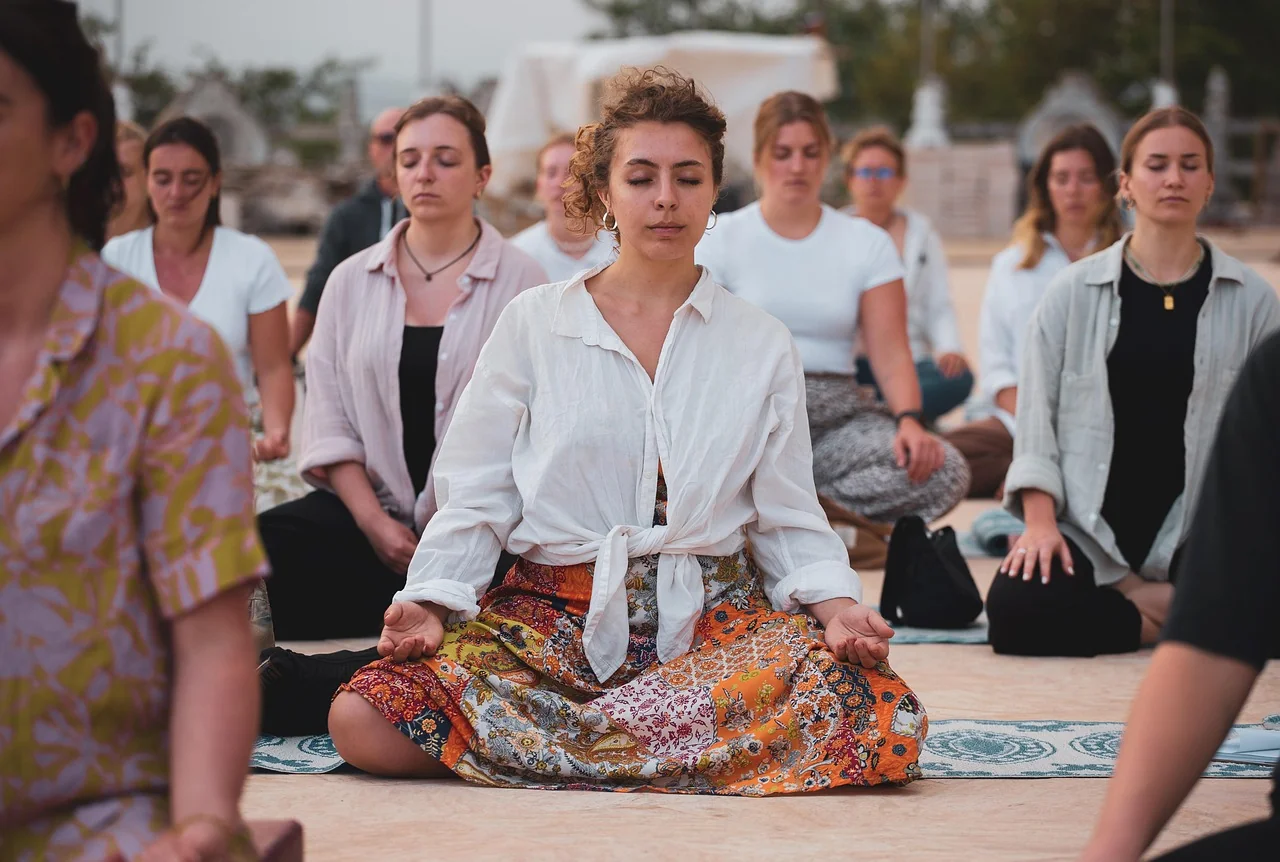Feeling like your mind is running a million miles an hour while your body is tied in knots? You’re not alone. In our non-stop world, it's easy to lose touch with the physical self, holding onto stress and tension without even realizing it. This is where learning how to do body scan meditation can be a game-changer. It’s a powerful mindfulness technique that acts like a systematic check-in with your entire body, from your toes to the top of your head.
This guide is your complete roadmap. We’ll first explore the profound benefits, from melting away stress to improving your sleep, so you understand exactly why this practice is so effective. Then, we’ll walk you through a detailed, step-by-step guide to the practice itself, followed by essential tips for navigating common beginner challenges. Get ready to unlock a deeper sense of calm and reconnect with your body in just a few minutes a day.
What is Body Scan Meditation? A Path to Mind-Body Connection
Body scan meditation is a foundational mindfulness practice that involves mentally sweeping through your body, part by part. Unlike meditation styles that focus exclusively on the breath, the body scan uses the physical body as the anchor for your attention. The goal isn’t to achieve a perfectly blank mind or to force relaxation. Instead, it’s to cultivate a curious and non-judgmental awareness of whatever physical sensations you discover—whether that’s warmth, coolness, tingling, tension, or even a complete lack of sensation.
Think of it as a gentle tour of your inner landscape. You are the curious explorer, and your body is the territory you are getting to know. This process helps bridge the gap between a busy mind and a physical body that often bears the brunt of our stress, fostering a powerful sense of integration and presence.
The Profound Benefits of a Regular Body Scan Practice
Committing to a regular body scan practice offers a cascade of benefits that touch nearly every aspect of your well-being. It’s more than just a relaxation technique; it’s a tool for training your mind and healing your nervous system.
- Reduces Stress and Anxiety: By consciously noticing areas of tension and consciously releasing them, you signal safety to your nervous system. This can lower cortisol levels and interrupt the cycle of the stress response, leading to a calmer state.
- Improves Sleep Quality: The body scan is a perfect pre-bed ritual. It pulls your awareness away from racing thoughts and into the physical body, promoting the deep relaxation necessary for falling and staying asleep.
- Enhances Body Awareness: Many of us operate on autopilot, ignoring our body’s signals until they become screams of pain or burnout. The body scan trains you to notice subtle cues of discomfort or stress early, allowing you to address them before they escalate.
- Helps Manage Chronic Pain: This practice doesn’t aim to eliminate pain magically. Instead, it helps you change your relationship to it. By observing pain with curiosity rather than resistance, you can reduce the secondary suffering—the fear and frustration—that often amplifies it.
- Cultivates Present-Moment Awareness: The body scan is a powerful anchor to the here and now. Your body is always in the present moment; by tuning into it, you are pulled out of regrets about the past or anxieties about the future.
How to Do a Body Scan Meditation: A Step-by-Step Guide
This step-by-step guide will walk you through the entire process. Set aside 10-20 minutes where you won’t be interrupted.
Find Your Position and Setting
Lie down on your back on a yoga mat, carpet, or your bed. You can place a pillow under your head and knees for support. If lying down makes you sleepy, you can also sit upright in a comfortable chair with your feet flat on the floor. Ensure the room is a comfortable temperature and dim the lights. The goal is to be comfortable and supported so you can focus on the practice, not on adjusting your position. For more tips on creating the perfect environment, check out our guide on how to set up a meditation space.
Begin with a Few Conscious Breaths
Gently close your eyes if that feels comfortable. Bring your attention to the natural flow of your breath. Don’t try to control it. Simply notice the sensation of the air moving in and out of your body, and the gentle rise and fall of your chest or abdomen. Do this for 6-10 breath cycles to help settle your mind and transition into a more mindful state. If you struggle with a busy mind, a short meditation to clear the mind beforehand can be very helpful.
The Scanning Process: A Journey of Attention
Now, begin the journey of bringing your attention systematically through your body. You can start from your toes and move up to your head, or from your head down to your toes. Move slowly, spending about 20-30 seconds on each part.
- Bring your awareness to the toes of your left foot. Notice any sensations there—warmth, coolness, the feeling of your socks, or perhaps no distinct sensation at all. Simply observe.
- Expand your awareness to include the entire left foot: the sole, the heel, the top of the foot.
- Gently move your attention to your left ankle, then your lower leg, knee, and thigh.
- Repeat this entire process for the right leg, starting with the toes and moving up to the thigh.
- Bring your awareness to your pelvic region, hips, and buttocks.
- Move up to your lower back, abdomen, and then your upper back and chest.
- Notice the sensations in your shoulders, then move down through your left arm: upper arm, elbow, forearm, wrist, hand, and each individual finger. Repeat for the right arm.
- Bring attention to your neck and throat.
- Finally, move through the parts of your face and head: jaw, lips, nose, cheeks, eyes, ears, forehead, and the very crown of your head.
Meeting Sensations Without Judgment
This is the heart of the practice. As you scan, you might encounter areas of tightness, pain, or numbness. The instruction is to simply acknowledge the sensation without labeling it as "good" or "bad." You don’t need to change it. If you find tension in your shoulders, for example, you might mentally note, "Ah, there is tension here," and breathe into that area, allowing it to be exactly as it is. This attitude of acceptance is what allows deep release to occur.
Gently Returning from Wandering Thoughts
Your mind will wander. It’s not a matter of if, but when. This is completely normal and an expected part of the practice. When you notice your attention has drifted to a thought, a sound, or a memory, gently acknowledge it without self-criticism. You can softly say to yourself, "Thinking," and then guide your attention back to the part of the body you last remember. This act of noticing and returning is the core strengthening exercise of mindfulness.
Closing the Practice
Once you have scanned your entire body, spend a few moments basking in the awareness of your body as a complete, whole entity. Feel the entire body breathing. From this expanded awareness, take three deeper, conscious breaths. Gently begin to wiggle your fingers and toes, slowly bringing movement back into the body. When you feel ready, slowly open your eyes and transition smoothly out of the practice.
5 Tips for an Effective Body Scan Meditation Session
Integrating these tips will help you build a sustainable and rewarding practice.
- Start Small: Don’t jump into a 45-minute session. Begin with just 5 or 10 minutes. You can even scan just one limb if you’re short on time. Consistency with a short practice is far more valuable than an infrequent long one.
- Be Kind to Your Wandering Mind: Treat yourself with the patience you would offer a friend who is learning a new skill. Every time you gently bring your attention back, you are succeeding at the practice.
- Experiment with Timing: Many people find that a body scan before bed promotes excellent sleep. Others prefer a midday scan to release accumulated stress. Try it at different times to see what serves you best.
- Use a Guided Meditation: Especially when starting out, using a guided body scan audio can be incredibly helpful. It removes the mental load of remembering the sequence and allows you to fully surrender to the instructions. You can use our guided body scan meditation script to get started.
- Let Go of Expectations: Approach each session with a "beginner's mind." Don’t expect to feel deeply relaxed or have a profound experience every time. Some sessions will feel easy, others will feel frustrating. The key is to show up and scan anyway, accepting whatever arises.
In essence, body scan meditation is a profoundly accessible practice for cultivating a deeper, more compassionate connection between mind and body. By systematically moving your attention from your toes to the crown of your head, you learn to observe physical sensations without judgment, releasing accumulated tension and quieting the mind's chatter. The key to success lies not in achieving a perfectly blank state, but in the gentle, consistent effort of returning your focus each time it wanders. This practice builds a foundational skill of present-moment awareness that can transform your relationship with stress and anxiety. We encourage you to integrate this powerful technique into your daily routine, starting with just a few minutes each day. Remember, every scan is an opportunity to nurture your well-being. Be patient with yourself as you embark on this journey of inner discovery, and trust that with regular practice, you will uncover a greater sense of calm and resilience that permeates all aspects of your life.


